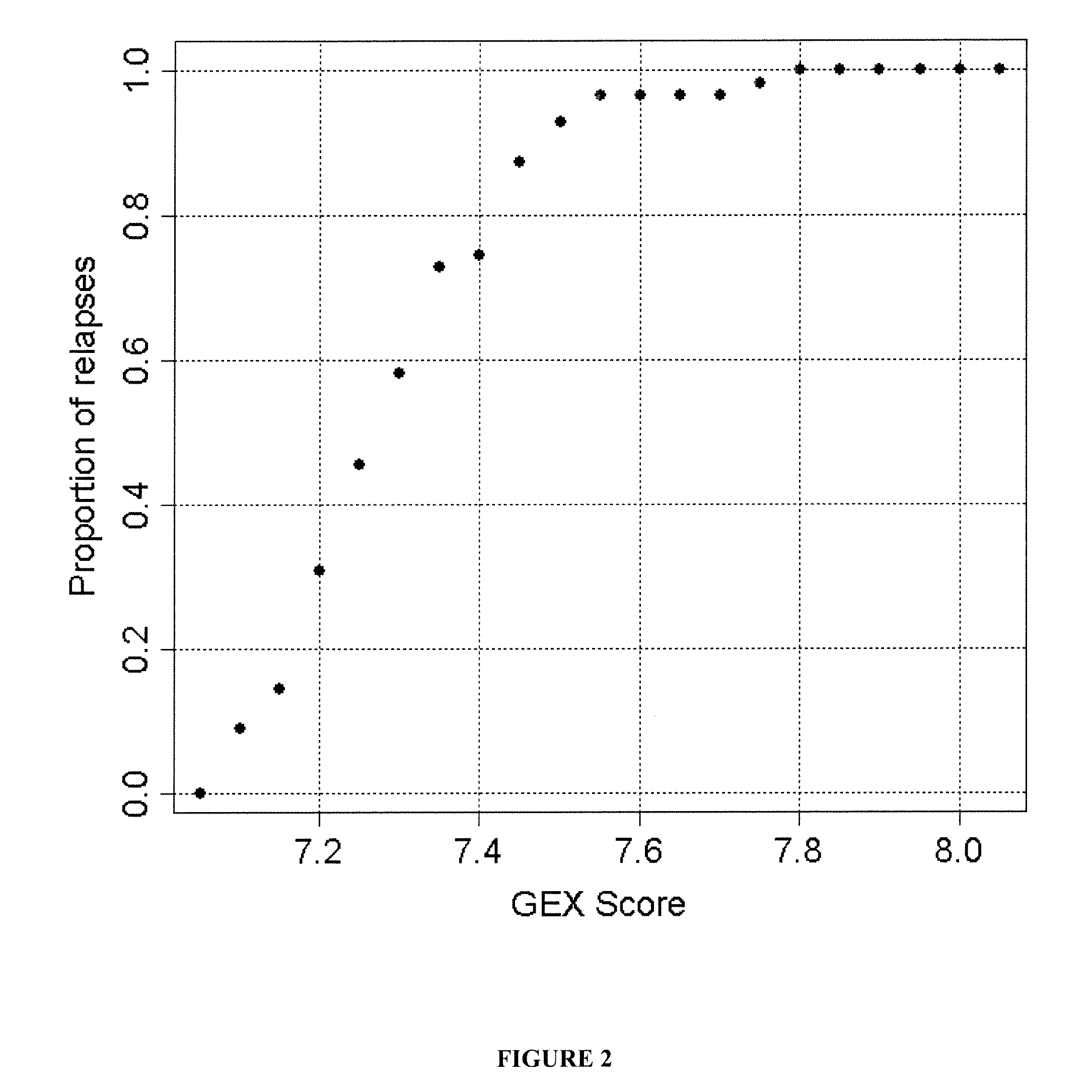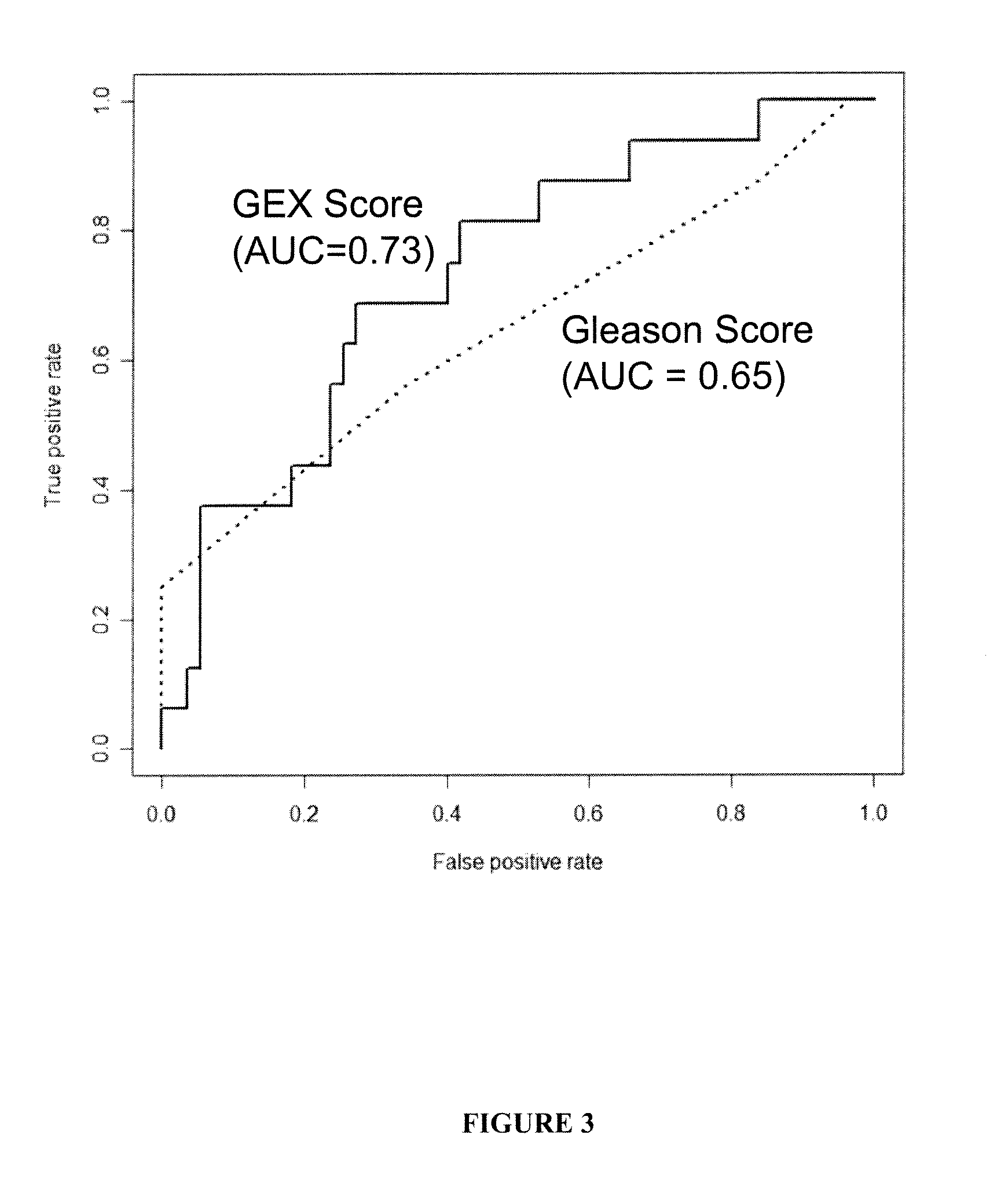Expression profiles to predict relapse of prostate cancer
a prostate cancer and expression profile technology, applied in the field of gene expression profiling, can solve the problems of ineffective local treatment, slow progress in prostate cancer treatment, and inability to accurately predict the relapse of prostate cancer, and achieve the effect of high resolution grading
- Summary
- Abstract
- Description
- Claims
- Application Information
AI Technical Summary
Benefits of technology
Problems solved by technology
Method used
Image
Examples
example i
Correlation between Gene Expression Signature and Gleason Score
[0091]This example shows the calculation of a Gene EXpression score (GEX), which is an expression analogy of Gleason score derived from 16 genes and which showed a better correlation (r=0.62) with Gleason score than correlation of any individual gene.
[0092]A candidate gene approach focused on a set of “informative” genes that are the most relevant to the subjects of this study was taken as has been described by (Lossos et al., N Engl J Med 350:1828-37 (2004); Paik et al., 2004; Ramaswamy et al., J Clin Oncol 20:1932-41, (2002); van de Vijver et al., N Engl J Med 347:1999-2009 (2002)). The genes were selected based on: (1) Biological relevance. These include tumor suppressor genes and oncogenes, genes that are indirectly involved in cancer development, for example, DNA repair genes; metastasis-inhibitor genes, genes regulated by various signaling pathways, and / or responsible for altered cell growth and differentiation, ap...
example ii
Gene Expression Profiles Predict Relapse of Prostate Cancer
[0112]This example shows the correlation between GEX score for a collection of 16 genes and prostate cancer relapse.
[0113]As shown in FIG. 2, there was a good correlation between the GEX score and relapse and a near-linear increase in percent of relapse cases with GEX score between 7 and 7.6 (FIG. 2). For instance, when GEX score was 7.4, approximately 75% of the cases relapsed. When the GEX score reached 7.8, 100% of the cases relapsed. It is worth noting that the average GEX score was 7.2 for GS7 patients without relapse and 7.4 for GS7 patients who relapsed, corresponding to 20% and 75% of the chance of relapse, respectively.
[0114]The Receiver Operating Characteristic (ROC) curve showed that the 16 gene expression signature was more predictive of relapse than Gleason score (FIG. 3). The GEX score had an AUC (Area Under the Curve) of 0.73, which was better than Gleason score with an AUC 0.65. The Sensitivity and Specificit...
example iii
An Expanded Collection of Signature Genes That Predict Relapse of Prostate Cancer
[0125]This example shows the correlation between GEX score for a collection of 21 genes and prostate cancer relapse.
[0126]The correlation between GEX score and Gleason score was re-evaluated for the set of 512 genes shown in Table 3 as follows. GEX score was determined for each of the 512 genes in each of the 71 samples as described in Example I. All genes that had a correlation outside of the median±2 standard deviations were identified. This resulted in the addition of the GI 2094528, KIP2, NRG1, NBL1, and Prostein genes to the list of 16 genes described in Examples I and II. The resulting collection of 21 genes shown in Table 4.
[0127]
TABLE 4Collection of 21 signature genesGeneIDCorrelationCCNE20.36426CDC60.37274FBP10.33746HOXC60.50382MKI670.39223MYBL20.37886PTTG10.38212RAMP0.44857UBE2C0.32517Wnt5A0.39458memD0.35123GI_20945280.30986KIP2−0.31881NRG1−0.27405NBL1−0.32061Prostein−0.26023AZGP1−0.35498CCK−0...
PUM
 Login to View More
Login to View More Abstract
Description
Claims
Application Information
 Login to View More
Login to View More - R&D
- Intellectual Property
- Life Sciences
- Materials
- Tech Scout
- Unparalleled Data Quality
- Higher Quality Content
- 60% Fewer Hallucinations
Browse by: Latest US Patents, China's latest patents, Technical Efficacy Thesaurus, Application Domain, Technology Topic, Popular Technical Reports.
© 2025 PatSnap. All rights reserved.Legal|Privacy policy|Modern Slavery Act Transparency Statement|Sitemap|About US| Contact US: help@patsnap.com



